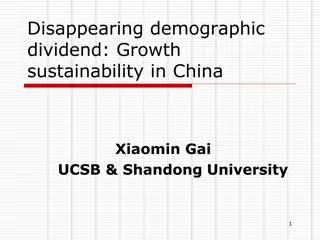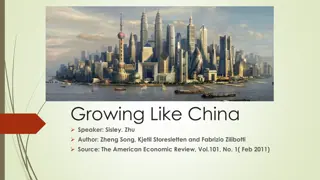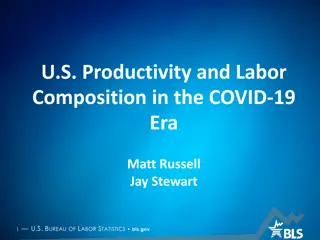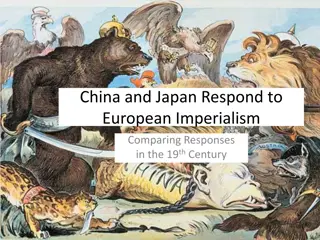Industry Productivity Growth in China: Sources & Prospects
Delve into the growth landscape of China's industry productivity, exploring factors such as prices, labor input, and institutional changes. Previous studies provide insight into value-added growth, capital, labor input, and total factor productivity. Data challenges and research methodologies are highlighted, emphasizing the quest for accurate measurement. Our current work involves utilizing industrial productivity databases and services price proxies to enhance analysis.
Download Presentation

Please find below an Image/Link to download the presentation.
The content on the website is provided AS IS for your information and personal use only. It may not be sold, licensed, or shared on other websites without obtaining consent from the author.If you encounter any issues during the download, it is possible that the publisher has removed the file from their server.
You are allowed to download the files provided on this website for personal or commercial use, subject to the condition that they are used lawfully. All files are the property of their respective owners.
The content on the website is provided AS IS for your information and personal use only. It may not be sold, licensed, or shared on other websites without obtaining consent from the author.
E N D
Presentation Transcript
Industry Productivity Growth in China and Prospects for Growth Jing Cao , Mun S. Ho* Xianchun Xu and Hang Yu** *Harvard University, Tsinghua University, and ** Beijing University World KLEMS Conference 2018 World KLEMS Conference 2018 Harvard University Harvard University June 4, 2018 June 4, 2018
Introduction Continued debate on the sources of the growth Measurement of prices, import prices Measurement of capital and land Difficulties in FISIM, Housing imputation Labor input and Institutional changes affecting future growth: Relax restrictions on labor flows Retirement reform
Previous Studies value value added added growth growth stock stock input input 9.16 6.64 6.61 7.72 4.94 4.95 9.15 6.18 6.11 11.23 8.56 8.49 10.3 10.55 10.57 capital capital capital capital labor labor hours hours labor labor input input TFP Studies TFP Studies Period Period 1980-2010 1980-1991 1991-2001 2001-2007 2007-2010 1980-2012 1980-1991 1991-2000 2001-2007 2007-2012 1980-2000 1982-1984 1984-1988 1988-1994 1994-2000 1978-2007 1978-1988 1988-1998 1998-2007 1979-1990 1991-2000 2001-2010 2011-2014 TFP TFP Note Note 0.96 1.34 0.88 0.71 0.36 1.32 1.39 1.26 1.19 1.53 1.24 1.39 1.79 1.57 -1.8 0.94 1.25 1.19 1.6 -1.07 2.51 9.12 3.26 2.64 -0.31 3.92 4.19 3.05 4.58 Wu(2015) KLEMS, CIP 3.0 Wu and Zhang (2016) updated to 2012 (ATFP) 8.91 12.5 10.2 7.81 7.96 8.75 3.11 8.84 6.73 12.58 3.89 3.73 4.66 3.41 3.91 Cao, Ho, Jorgenson, Ren, Sun and Yue (2009) KLEM, Aggregate Production Possibility Frontier, reallocation of capital is -0.17 and reallocation of labor is -0.02 Simple growth accounting, VA adjusted by quantity; Adjusted deflator and capital stock, GDP is lower than official Bandt and Zhu (2010), Zhu (2012) 9 3.4 2.5 1.5 1.2 1.1 2 Simple growth accounting, official NBS data with Education adjsuted labor input Wang Xiaolu (2017) 10.4 10.5 8.1 4 3.5 2.4 -0.4 5.1 5.4
Data issues Time series based on IO benchmarks 1981,87,92,97,2002,07,12 note: has changes in classifications No time series of gross output by industry; interpolate using Value-added in Nat Ac. available 9 sectors. . Little data on land and mixed income PPI s only for agriculture, manufacturing, mining, utilities For services PPIs Wu (2015) used CPI s, wages, etc
Our work here Use Harry Wu et al. (2015) (RIETI China Industrial Productivity database) for nominal IO 1985-2010 Try different proxies for services PPI s Add estimates of Import prices (to be completed)
Comparison of price deflators Industry CIP's price index NBS deflator PPI in this research implicit deflator calculated from NBS nominal and real VA Wholesales & retails (27) Urban consumer price index (CPI) By quantity of transactions Hotels and restaurants (28) implicit deflator calculated from NBS nominal and real VA Urban consumer price index (CPI) Part of CPI, weighted Transport component of CPI, excluding price of equipment (vehicles) Transport, storage, post (29) By quantity trend estimation implicit deflator calculated from NBS nominal and real VA CPI of tele; wage index of computer and software Information services (30) Telecommunication component of CPI cpi and wage index (simple average)
Comparison of price deflators CIP CIP's price index NBS PPI PPI in this research Classification Average of transport, communication, rental and utilities components of CPI Implicit service charge per meter2 for 1993 onwards and assumed to move along with housing component of CPI implicit deflator calculated from NBS nominal and real VA Financial services (31) Component index implicit deflator calculated from NBS nominal and real VA Real estate services (32) Component index Business services (33) Government (34) As financial services (31) CPI; wage indexWage index, without CPI Urban consumer price index (CPI) wage index by sectors Wage index
Comparison of price deflators CIP CIP's price index NBS PPI PPI in this research Classification Based on education components of CPI before 2006; adjusted to CPI trend afterwards wage index of education Education (35) CPI Health: people received services; Social security: wage index Based on average spending of per hospital visit per outpatient (MoH, various issues) Healthcare, social security (36) wage index of three industries
Comparing CIP deflators with our proxies for service industries
Using the new price proxies, we estimated TFP using the CIP data for nominal output, real capital and labor input. (this version assume import price = domestic price)
TFP comparisons Full( Services I) : Transportation, Telecom, Finance Sate Monopolized(Services II): Trade, Hotel, Real estate, Tech & Bus svc, Other svc Non-mkt (ServicesIII) : Public admin, Education, Health&Social The Non-market Sectors have smaller TFP growth when we proxy output price with Wage index
Chinas Growth Prospects Labor dimension Projection of labor input accounting for aging, retirement reform, urbanization and educational improvement
Historical labor input, Wu et al. (2015) Employment, hours and effective labor input 3000000 2500000 2000000 1500000 1000000 500000 0 1975 1980 1985 1990 1995 2000 2005 2010 2015 Employment (1000) Hours (mil) Eff labor Growth rate 1980-2010: Employment: 1.6%; Effective Labor 2.8%; Labor quality: 0.76%
Projection of population and hours due to retirement reform 1100 2600 Working-Age Population Hours; Retirement Reform Hours; Base case 2400 1000 2200 900 Million. Population Billion. Hours 2000 800 1800 700 1600 600 1400 500 1200 2010 2015 2020 2025 2030 2035 2040 2045 2050
Projected educational attainment 100% 90% 80% 70% 60% College+ Senior High Junior High Primary Illiteracy 50% 40% 30% 20% 10% 0% 2010 2050 2010 2050 2010 2050 Total Urban Rural
Labor input accounting for education, aging and retirement reform 120% 110% Labor Input (2010=100%) 100% 90% Hours Worked 80% Labor input; Base case 70% Labor input; Retirement Ref. 60% 2010 2015 2020 2025 2030 2035 2040 2045 2050
Conclusions oIndustry level accounts for China still faces many fundamental problems oExpansion of PPI coverage to growing Services is key oFuture work: - include import price estimates - improve FISIM and Housing output measures























